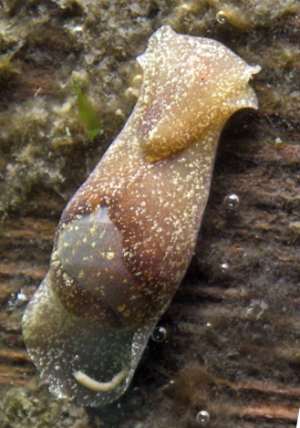
Haminoea virescens
(Sowerby, 1833)
Order: CEPHALASPIDEA
Family: Haminoeidae
DISTRIBUTION
West Coast of North America from Alaska to Panama (Behrens, 1991).
PHOTO
Lagoon Point,Whidbey Island.Washington, USA. Eastern Pacific Ocean. Depth: 6 inches. Length: 1 inch. 9 June 2005. floating dock. Photographer: Jan Kocian
According to Abbott (1954), this is a species of the open coast. The background colour of the body varies from a translucent brown to translucent green with milky yellow spots, which are also visible on the mantle which can be seen through the trasparent shell. White mottling can also be present of the parapodia. It grows to at least 18 mm in length.
The shell, like most of the genus is thin, and fragile with a sunken spire. It is transparent to translucent and yellowish-green in colour.
-
Abbott, R.T. (1954). American Seashells. 1st Edition, D. Van Nostrand Company, Inc., Princeton, New Jersey, 541 pp.
-
Costa, A. (1869). Appendice al saggio sui molluschi Aeolididae del golfo Napoli. Annu. Mus. zool. Napoli, 5: 46-48
- Gibson & Chia. (1989) Description of a new species of Haminoea.. Canadian Journal of Zoology, 67(4): 914-922. .
-
Marcus, Ernst. 1961. Opisthobranch Mollusks from California. The Veliger, 3 (Supplement).
-
Sowerby, J. (1833). The Genera of Recent and fossil shells, for the use of students in conchology and geology. Part 39, Bulla, pl. 31, figs 1-8. London: Sowerby
Rudman, W.B., 2005 (September 19) Haminoea virescens (Sowerby, 1833). [In] Sea Slug Forum. Australian Museum, Sydney. Available from http://www.seaslugforum.net/find/hamivire
Related messages
Haminoea virescens from Puget Sound
September 19, 2005
From: Jan Kocian

Hello Mr, Rudman
Enclosed couple of photos of what I think is Melanochlamys diomedea I found on floating dock while changing zincs on friend's boat.
Locality: Lagoon Point,Whidbey Island.Washington, USA. Eastern Pacific Ocean. Depth: 6 inches. Length: 1 inch. 9 June 2005. floating dock. Photographer: Jan Kocian
Egg ribbon I assume belongs to it as well, since I did not see any other nudibranch in the vicinity. However, one cannot be sure, it was during daylight and the bottom of the dock is covered with sealife. Could you confirm my guess? I don't see any other photos of this slug on the Forum. Thank you,
Jan Kocian.
honkoc@hotmail.com
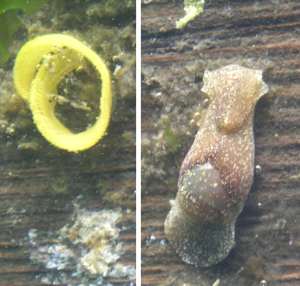
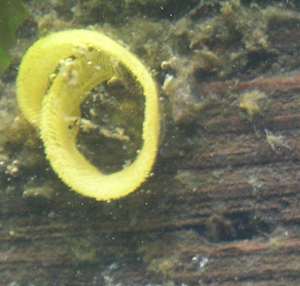
Dear Jan,
There are some photos of Melanochamys diomedea on the Forum but they are all from the NW Pacific. Have a look at the Related Messages attached to the species Fact Sheet. There is usually a lot of information on each species hidden in these messages. I have got a photo on the actual Fact Sheet as I would like to include a photo from the Nth American west coast, where it was first described, but I haven't got one yet.
Now to your animal. Although it looks quite like Melanochlamys diomedea it is another bubble shell, Haminoea virescens. Species of Haminoea are herbivores feeding on green algae and diatoms. Their shells often wash up in large bumbers and the glassy, bubble-shaped appearance have given the group they belong to the name of 'bubble shells' [see shells of Haminoea zelandiae]
It is possible the egg mass is that of H. virescens, but I would need some confirmation from Nth American experts. The species of Haminoea I am familar with have more sausage-shape egg ribbons but it is possible this species is different. [In the lower left photo I have kept the egg ribbon and animal at the same magnification].
Best wishes,
Bill Rudman
Haminoea virescens from Mexico
February 25, 2003
From: Alicia Hermosillo
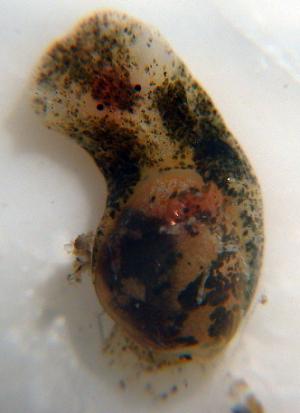
Dear Bill,
Since you have asked for a photo of Haminoea virescens, here is a picture for you.
Mismaloya, Bahia de Banderas, Pacific Coast of Mexico. 13 January 2003, 20 feet deep, 5 mm long.
I hope it is useful
Ali
gueri25@hotmail.com
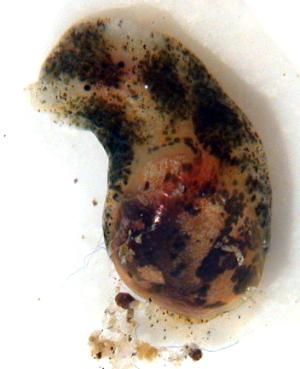
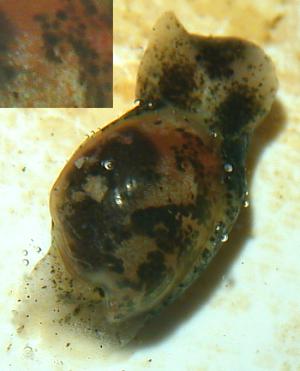
Thanks Ali,
I hate to be hesitant in accepting your gift, but I would be grateful for some guidance on whether it is H. virescens or H. vesicula. I have never seen either species, but from what I can gather from previous messages and various books, H. virescens has a greener animal and mantle than this. Perhaps its just because their juveniles. Any guidance will be very welcome
Best wishes,
Bill Rudman
Re: my Haminoea virescens query
November 16, 1998
From: Jessica Beaubier
Dear Dr. Rudman,
Thanks very much for taking the time to help me out, it's very much appreciated! If anything, this project has certainly gotten me familiar with all of the awesome slug websites out there, there are some incredible photographs!
Thanks again for the references! -I'll let you know how my paper turns out!
Sincerely,
Jessica
jessicab@uvic.ca
Beaubier, J., 1998 (Nov 16) Re: my Haminoea virescens query. [Message in] Sea Slug Forum. Australian Museum, Sydney. Available from http://www.seaslugforum.net/find/309Looking forward to hearing how it turns out.
Best wishes
Bill Rudman.
Haminoea virescens
November 13, 1998
From: Clay Carlson
Some drawings of H. virescens can be found in Marcus, Ernst. 1961. Opisthobranch Mollusks from California. The Veliger, 3(Supplement) Pl. 1, figs. 5 -9. Shell, radula, male system.
Gibson & Chia. 1989. Description of a new species of Haminoea .. Canadian Journal of Zoology, 67(4):914-922. fig. 4. Shell, Hancock's organs, male system; fig. 7 SEM of radula; fig. 8c SEM of gizzard plate.
Clay Carlson.
ccarlson@kuentos.guam.net
Carlson, C. & Hoff, P.J., 1998 (Nov 13) Haminoea virescens. [Message in] Sea Slug Forum. Australian Museum, Sydney. Available from http://www.seaslugforum.net/find/297Haminoea virescens
November 10, 1998
From: Jessica Beaubier
Dear Dr. Rudman,
I am an undergraduate student at the University of Victoria in British Columbia. As part of my invertebrates class I have to locate information and prepare a report on Haminoea virescens (the green paper bubble). Unfortunately I have been unable to find any information beyond a morphological description. I found your name while perusing the Opisthobranch sites, recognized it from the references I've been sifting through, and thought that you might be able to offer some insight into this species that seems largely ignored. Any advice or information would be greatly appreciated!
Thanks for your time!
Sincerely,
Jessica Beaubier
jessicab@uvic.ca
Beaubier, J., 1998 (Nov 10) Haminoea virescens. [Message in] Sea Slug Forum. Australian Museum, Sydney. Available from http://www.seaslugforum.net/find/295Dear Jessica,
Offhand I don't know of any studies on the biology of Haminoea virescens. If anyone else does could that let us know please. I have posted a picture of a tropical species, Haminoea cymbalum which is a most unusual member of the genus in being brightly coloured.
I am puzzled by Abbott's note that H. virescens is a species of the open coast, because most species of the genus live in sheltered bays and estuaries on sand flats or sandy-mud. I know of a couple of interesting studies on species of Haminoea which should be available to you.
One of these describes the ability of the European species, Haminoea navicula, to change colour to match its surroundings. The colour pigments in its skin are contained in ramifying epithelial and subepithelial cells. By the extension and contraction of parts of these "melanophores" colour pigments can be moved or obscured so that the skin colour can change from black or dark brown to white in four or five hours. (Edlinger,1982).
It is probable at least some of the many other species which are mottled in patches of browns, greys and blacks also have the ability to change colour.
The other describes the relationship between growth and reproduction in Haminoea japonica and the seasonal occurrence of its algal food.
References:
Edlinger,K., 1982. Colour adaption in Haminoea navicula (da Costa) (Mollusca: Opisthobranchia). Malacologia, 22: 593-600.
Ito,K., Goshima,S. & Nakao,S. 1996. Growth and reproduction of the generalist opisthobranch Haloa japonica: effect of algal seasonality on growth rate. Marine Biology, 126: 395-401.
Rudman, W.B., 1998 (Nov 10). Comment on Haminoea virescens by Jessica Beaubier. [Message in] Sea Slug Forum. Australian Museum, Sydney. Available from http://www.seaslugforum.net/find/295